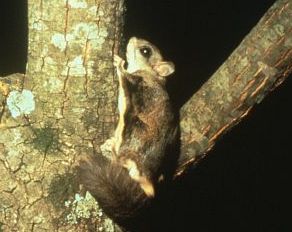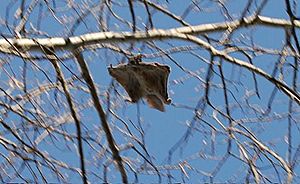Flying squirrel facts for kids
Quick facts for kids Flying squirrelTemporal range: Early Oligocene – Recent
|
|
|---|---|
 |
|
| Northern flying squirrel (Glaucomys sabrinus) | |
| Scientific classification |
|
| Kingdom: | Animalia |
| Phylum: | Chordata |
| Class: | Mammalia |
| Order: | Rodentia |
| Family: | Sciuridae |
| Subfamily: | Sciurinae |
| Tribe: | Pteromyini Brandt, 1855 |
| Genera | |
|
Aeretes |
|
Flying squirrels (scientifically known as Pteromyini or Petauristini) are a tribe of 50 species of squirrels in the family Sciuridae. Despite their name, they are not in fact capable of full flight in the same way as birds or bats, but they are able to glide from one tree to another with the aid of a patagium, a furred parachute-like skin membrane that stretches from wrist to ankle. Their long tails also provide stability as they glide. Anatomically they are very similar to other squirrels with a number of adaptations to suit their lifestyle; their limb bones are longer and their hand bones, foot bones, and distal vertebrae are shorter. Flying squirrels are able to steer and exert control over their glide path with their limbs and tail.
Molecular studies have shown that flying squirrels are monophyletic and originated some 18–20 million years ago. The genus Paracitellus is the earliest lineage to the flying squirrel dating back to the late Oligocene era. Most are nocturnal and omnivorous, eating fruit, seeds, buds, flowers, insects, gastropods, spiders, fungi, bird's eggs, tree sap and young birds. The young are born in a nest and are at first naked and helpless. They are cared for by their mother and by five weeks are able to practice gliding skills so that by ten weeks they are ready to leave the nest.
Some captive-bred southern flying squirrels have become domesticated as small household pets, a type of "pocket pet".
Description
Flying squirrels are not capable of flight like birds or bats; instead, they glide between trees. They can fly at 90 metres (300 ft).
The flying squirrel changes its direction and speed in midair by adjusting the positions of its limbs. Tha squirrel has a cartilage projection from the wrist. The animal holds upwards during a glide. Only flying squirrels have this specialized cartilage, other gliding mammals do not have it. The flying squirrel has a fluffy tail that stabilizes in flight. The tail also acts as an air brake before landing on a tree trunk.
Several hypotheses have attempted to explain the evolution of gliding in flying squirrels. One possible explanation is related to energy efficiency and foraging. Gliding is an energetically efficient way to progress from one tree to another while foraging, as opposed to climbing down trees and maneuvering on the ground floor or executing dangerous leaps in the air. By gliding at high speeds, flying squirrels can rummage through a greater area of forest more quickly than tree squirrels.
Other hypotheses state that the mechanism evolved to avoid nearby predators and prevent injuries. If a dangerous situation arises on a specific tree, flying squirrels can glide to another, and thereby typically escape the previous danger.
Fluorescence
In 2019 it was observed, by chance, that a flying squirrel fluoresced pink. Subsequent research by biologists at Northland College in Northern Wisconsin found that this is true for all three species of North American flying squirrels. At this time it is unknown what purpose this serves. Non-flying squirrels do not fluoresce under UV light.
Living species
The three species of the genus Glaucomys (Glaucomys sabrinus, Glaucomys volans and Glaucomys oregonensis) are native to North America and Central America; many other taxa are found throughout Asia as well, with the range of the Siberian Flying Squirrel (Pteromys volans) reaching into parts of northeast Europe (Russia, Finland and Estonia).
Thorington and Hoffman (2005) recognize 15 genera of flying squirrels in two subtribes.
Life cycle
The life expectancy of flying squirrels in the wild is about six years, and flying squirrels can live up to fifteen years in zoos. The mortality rate in young flying squirrels is high because of predators and diseases. Predators of flying squirrels include tree snakes, raccoons, owls, martens, fishers, coyotes, bobcats, and feral cats. In the Pacific Northwest of North America, the northern spotted owl (Strix occidentalis) is a common predator of flying squirrels.
Flying squirrels are usually nocturnal, since they are not adept at escaping birds of prey that hunt during the daytime. They eat according to their environment; they are omnivorous, and will eat whatever food they can find. The North American southern flying squirrel eats seeds, insects, gastropods (slugs and snails), spiders, shrubs, flowers, fungi, and tree sap.
Reproduction
The mating season for flying squirrels is during February and March. When the infants are born, the female squirrels live with them in maternal nest sites. The mothers nurture and protect them until they leave the nest. The males do not participate in nurturing their offspring.
At birth, flying squirrels are mostly hairless, apart from their whiskers, and most of their senses are not present. Their internal organs are visible through the skin, and their sex can be signified. By week five, they are almost fully developed. At that point, they can respond to their environment and start to develop a mind of their own. Through the upcoming weeks of their lives, they practice leaping and gliding. After two and a half months, their gliding skills are perfected, they are ready to leave the nest, and are capable of independent survival.
Diet
Flying squirrels can easily forage for food in the night, given their highly developed sense of smell. They harvest fruits, nuts, fungi, and birds' eggs. Many gliders have specialized diets and there is evidence to believe that gliders may be able to take advantage of scattered protein deficient food. Additionally, gliding is a fast form of locomotion and by reducing travel time between patches, they can increase the amount of foraging time.
See also
 In Spanish: Pterominos para niños
In Spanish: Pterominos para niños



